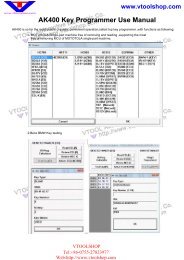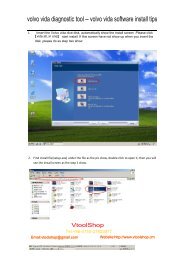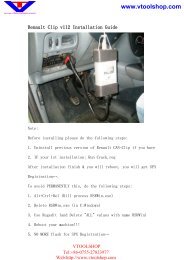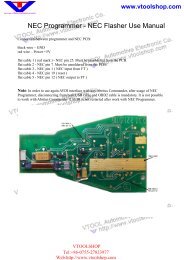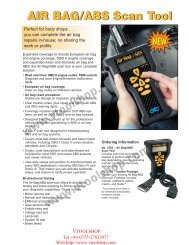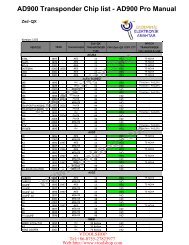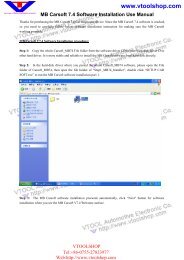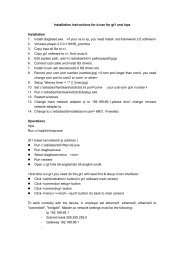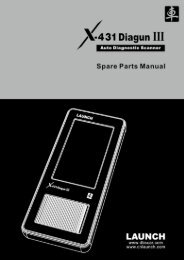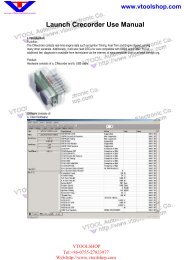GS400 OBDII Scan Tool Manual.pdf - Car diagnostic tool
GS400 OBDII Scan Tool Manual.pdf - Car diagnostic tool
GS400 OBDII Scan Tool Manual.pdf - Car diagnostic tool
Create successful ePaper yourself
Turn your PDF publications into a flip-book with our unique Google optimized e-Paper software.
Table of Contents<br />
www.v<strong>tool</strong>shop.com<br />
1. Safety Precautions and Warnings…….………………………..2<br />
2. General Information<br />
2.1 On-Board-Diagnostics (OBD) II ..……….…………….…..3<br />
2.2 Diagnostic Trouble Codes (DTCs)…………………………3<br />
2.3 Location of the Data Link Connector (DLC)………………4<br />
2.4 OBD II Readiness Monitors……………………………. . ..5<br />
2.5 OBD II Monitor Readiness Status………………………….6<br />
2.6 OBD II Definitions…………………………………………7<br />
3. Product Information<br />
3.1 <strong>Tool</strong> Description ……………………………………………9<br />
3.2 Product Specifications…...…………………………………10<br />
3.3 Accessories Included…………………...………………….11<br />
3.4 Navigation Characters …………………………………….11<br />
3.5 Keyboard……..……………………………………………11<br />
3.6 Power…………………..…………………………………..11<br />
3.7 Product Setup………………………………………………12<br />
3.8 Battery Replacement………….……………………...…….16<br />
3.9 Vehicle Coverage…………………………………..………17<br />
4. Operating Instructions<br />
4.1 Reading Codes ……………………………… ………….…18<br />
4.2 Erasing Codes……………………………… ………….......20<br />
4.3 Reading Freeze Frame Data………………… ……………..21<br />
4.4 Retrieving I/M Readiness Status……………… … ..………22<br />
4.5 Viewing Vehicle Information………………… …...……….24<br />
4.6 Saving <strong>Scan</strong> Results…………………………………….…..25<br />
4.7 Rescanning Data……………………………….. .………….27<br />
4.8 Reviewing Data……………..………..………… …..………27<br />
5. Warranty and Service ……………………………………… ..….29<br />
VTOOLSHOP<br />
Tel:+86-0755-27823977<br />
1<br />
Web:http://www.v<strong>tool</strong>shop.com
1. Safety Precautions and Warnings<br />
www.v<strong>tool</strong>shop.com<br />
To prevent personal injury or damage to vehicles and/or the scan<br />
<strong>tool</strong>, read this instruction manual first and observe the following<br />
safety precautions at a minimum whenever working on a vehicle:<br />
• Always perform automotive testing in a safe environment.<br />
• Wear safety eye protection that meets ANSI standards.<br />
• Keep clothing, hair, hands, <strong>tool</strong>s, test equipment, etc, away from all<br />
moving or hot engine parts.<br />
• Operate the vehicle in a well-ventilated work area; Exhaust gases<br />
are poisonous.<br />
• Put blocks on drive wheels and never leave vehicle unattended<br />
while running tests.<br />
• Use extreme caution when working around the ignition coil,<br />
distributor cap, ignition wires and spark plugs. These components<br />
create hazardous voltages when the engine is running.<br />
• Put transmission in PARK (for automatic transmission) or<br />
NEUTRAL (for manual transmission) and make sure the parking<br />
break is engaged.<br />
• Keep a fire extinguisher suitable for gasoline/chemical/ electrical<br />
fires nearby.<br />
• Don’t connect or disconnect any test equipment with ignition on or<br />
engine running.<br />
• Keep the scan <strong>tool</strong> dry, clean and free from oil, water and grease.<br />
Use a mild detergent on a clean cloth to clean the outside of the<br />
scan <strong>tool</strong>, when necessary.<br />
VTOOLSHOP<br />
Tel:+86-0755-27823977<br />
2<br />
Web:http://www.v<strong>tool</strong>shop.com
2. General Information<br />
2.1 On-Board Diagnostics (OBD) II<br />
The first generation of On-Board Diagnostics (called OBD I) was<br />
developed by the California Air Resources Board (ARB) and<br />
implemented in 1988 to monitor some of the emission control<br />
components on vehicles. As technology evolved and the desire to<br />
improve the On-Board Diagnostic system increased, a new generation of<br />
On-Board Diagnostic system was developed. This second generation of<br />
On-Board Diagnostic regulations is called "OBD II".<br />
The OBD II system is designed to monitor emission control systems and<br />
key engine components by performing either continuous or periodic<br />
tests of specific components and vehicle conditions. When a problem is<br />
detected, the OBD II system turns on a warning lamp (MIL) on the<br />
vehicle instrument panel to alert the driver typically by the phrase of<br />
“Check Engine” or “Service Engine Soon”. The system will also store<br />
important information about the detected malfunction so that a<br />
technician can accurately find and fix the problem. Here below follow<br />
three pieces of such valuable information:<br />
1) Whether the Malfunction Indicator Light (MIL) is commanded<br />
'on' or 'off';<br />
2) Which, if any, Diagnostic Trouble Codes (DTCs) are stored;<br />
3) Readiness Monitor status.<br />
2.2 Diagnostic Trouble Codes (DTCs)<br />
www.v<strong>tool</strong>shop.com<br />
OBD II Diagnostic Trouble Codes are codes that are stored by the onboard<br />
computer <strong>diagnostic</strong> system in response to a problem found in the<br />
vehicle. These codes identify a particular problem area and are intended<br />
to provide you with a guide as to where a fault might be occurring<br />
within a vehicle. OBD II Diagnostic Trouble Codes consist of a fivedigit<br />
alphanumeric code. The first character, a letter, identifies which<br />
control system sets the code. The other four characters, all numbers,<br />
provide additional information on where the DTC originated and the<br />
operating conditions that caused it to set. Here below is an example to<br />
illustrate the structure of the digits:<br />
VTOOLSHOP<br />
Tel:+86-0755-27823977<br />
3<br />
Web:http://www.v<strong>tool</strong>shop.com
DTC Example<br />
P 0 2 0 2<br />
Systems<br />
B=Body<br />
C=Chassis<br />
P=Powertrain<br />
U=Network<br />
Identifying specific<br />
malfunctioning<br />
section of the<br />
systems<br />
Code Type<br />
Generic (SAE):<br />
P0, P2, P34-P39<br />
B0, B3<br />
C0, C3<br />
U0, U3.<br />
Manufacturer Specific:<br />
P1, P30-p33<br />
B1, B2<br />
C1, C2<br />
U1, U2<br />
Sub-systems<br />
1= Fuel and Air Metering<br />
2= Fuel and Air Metering<br />
3= Ignition System or Engine Misfire<br />
4= Auxiliary Emission Controls<br />
5= Vehicle Speed Control and Idle<br />
Controls<br />
6= Computer Output Circuits<br />
7= Transmission Controls<br />
8= Transmission Controls<br />
2.3 Location of the Data Link Connector (DLC)<br />
The DLC (Data Link Connector or Diagnostic Link Connector) is the<br />
standardized 16-cavity connector where <strong>diagnostic</strong> scan <strong>tool</strong>s interface<br />
with the vehicle's on-board computer. The DLC is usually located 12<br />
inches from the center of the instrument panel (dash), under or around<br />
the driver’s side for most vehicles. If Data Link Connector is not located<br />
under dashboard, a label should be there telling location. For some Asian<br />
and European vehicles, the DLC is located behind the ashtray and the<br />
ashtray must be removed to access the connector. If the DLC cannot be<br />
found, refer to the vehicle’s service manual for the location.<br />
4
2.4 OBD II Readiness Monitors<br />
An important part of a vehicle’s OBD II system is the Readiness<br />
Monitors, which are indicators used to find out if all of the emissions<br />
components have been evaluated by the OBD II system. They are<br />
running periodic tests on specific systems and components to ensure that<br />
they are performing within allowable limits.<br />
Currently, there are eleven OBD II Readiness Monitors (or I/M<br />
Monitors) defined by the U.S. Environmental Protection Agency (EPA).<br />
Not all monitors are supported by all vehicles and the exact number of<br />
monitors in any vehicle depends on the motor vehicle manufacturer’s<br />
emissions control strategy.<br />
Continuous Monitors -- Some of the vehicle components or systems<br />
are continuously tested by the vehicle’s OBD II system, while others are<br />
tested only under specific vehicle operating conditions. The<br />
continuously monitored components listed below are always ready:<br />
1) Misfire<br />
2) Fuel System<br />
3) Comprehensive Components (CCM)<br />
Once the vehicle is running, the OBD II system is continuously checking<br />
the above components, monitoring key engine sensors, watching for<br />
engine misfire, and monitoring fuel demands.<br />
Non-Continuous Monitors -- Unlike the continuous monitors, many<br />
emissions and engine system components require the vehicle to be<br />
5
operated under specific conditions before the monitor is ready. These<br />
monitors are termed non-continuous monitors and are listed below:<br />
1) EGR System<br />
2) O2 Sensors<br />
3) Catalyst<br />
4) Evaporative System<br />
5) O2 Sensor Heater<br />
6) Secondary air<br />
7) Heated Catalyst<br />
8) A/C system<br />
2.5 OBD II Monitor Readiness Status<br />
OBD II systems must indicate whether or not the vehicle’s PCM’s<br />
monitor system has completed testing on each component. Components<br />
that have been tested will be reported as “Ready”, or “Complete”,<br />
meaning they have been tested by the OBD II system. The purpose of<br />
recording readiness status is to allow inspectors to determine if the<br />
vehicle’s OBD II system has tested all the components and/or systems.<br />
The powertrain control module (PCM) sets a monitor to “Ready” or<br />
“Complete” after an appropriate drive cycle has been performed. The<br />
drive cycle that enables a monitor and sets readiness codes to “Ready”<br />
varies for each individual monitor. Once a monitor is set as “Ready” or<br />
“Complete”, it will remain in this state. A number of factors, including<br />
erasing of <strong>diagnostic</strong> trouble codes (DTCs) with a scan <strong>tool</strong> or a<br />
disconnected battery, can result in Readiness Monitors being set to “Not<br />
Ready”. Since the three continuous monitors are constantly evaluating,<br />
they will be reported as “Ready” all of the time. If testing of a particular<br />
supported non-continuous monitor has not been completed, the monitor<br />
status will be reported as “Not Complete” or “Not Ready.”<br />
In order for the OBD monitor system to become ready, the vehicle<br />
should be driven under a variety of normal operating conditions. These<br />
operating conditions may include a mix of highway driving and stop and<br />
go, city type driving, and at least one overnight-off period. For specific<br />
information on getting your vehicle’s OBD monitor system ready, please<br />
consult your vehicle owner’s manual.<br />
6
2.6 OBD II Definitions<br />
Powertrain Control Module (PCM) -- OBD II terminology for the onboard<br />
computer that controls engine and drive train.<br />
Malfunction Indicator Light (MIL) -- Malfunction Indicator Light<br />
(Service Engine Soon, Check Engine) is a term used for the light on the<br />
instrument panel. It is to alert the driver and/or the repair technician that<br />
there is a problem with one or more of vehicle's systems and may cause<br />
emissions to exceed federal standards. If the MIL illuminates with a<br />
steady light, it indicates that a problem has been detected and the vehicle<br />
should be serviced as soon as possible. Under certain conditions, the<br />
dashboard light will blink or flash. This indicates a severe problem and<br />
flashing is intended to discourage vehicle operation. The vehicle<br />
onboard <strong>diagnostic</strong> system can not turn the MIL off until the necessary<br />
repairs are completed or the condition no longer exists.<br />
DTC -- Diagnostic Trouble Codes (DTC) that identify which section of<br />
the emission control system has malfunctioned.<br />
Enabling Criteria -- Also termed Enabling Conditions. They are the<br />
vehicle-specific events or conditions that must occur within the engine<br />
before the various monitors will set, or run. Some monitors require the<br />
vehicle to follow a prescribed “drive cycle” routine as part of the<br />
enabling criteria. Drive cycles vary among vehicles and for each monitor<br />
in any particular vehicle.<br />
OBD II Drive Cycle -- A specific mode of vehicle operation that<br />
provides conditions required to set all the readiness monitors applicable<br />
to the vehicle to the “ready” condition. The purpose of completing an<br />
OBD II drive cycle is to force the vehicle to run its onboard <strong>diagnostic</strong>s.<br />
Some form of a drive cycle needs to be performed after DTCs have been<br />
erased from the PCM’s memory or after the battery has been<br />
disconnected. Running through a vehicle’s complete drive cycle will<br />
“set” the readiness monitors so that future faults can be detected. Drive<br />
cycles vary depending on the vehicle and the monitor that needs to be<br />
reset. For vehicle specific drive cycle, consult the vehicle’s Owner’s<br />
<strong>Manual</strong>.<br />
7
www.v<strong>tool</strong>shop.com<br />
Freeze Frame Data -- When an emissions related fault occurs, the OBD<br />
II system not only sets a code but also records a snapshot of the vehicle<br />
operating parameters to help in identifying the problem. This set of<br />
values is referred to as Freeze Frame Data and may include important<br />
engine parameters such as engine RPM, vehicle speed, air flow, engine<br />
load, fuel pressure, fuel trim value, engine coolant temperature, ignition<br />
timing advance, or closed loop status.<br />
VTOOLSHOP<br />
Tel:+86-0755-27823977<br />
8<br />
Web:http://www.v<strong>tool</strong>shop.com
3. Product Information<br />
3.1 <strong>Tool</strong> Description<br />
8<br />
1<br />
10<br />
6<br />
7<br />
4<br />
2<br />
5<br />
2<br />
9<br />
3<br />
11<br />
1 LCD DISPLAY -- Indicates test results. Backlit, 128 x 64 pixel<br />
display with contrast adjustment.<br />
2 Y BUTTON -- Confirms a selection (or action) from a menu. When a<br />
DTC’s definition covers more than one screen, it is used to move<br />
down to the next screen for additional data.<br />
9
3 N BUTTON -- Cancels a selection (or action) from a menu or returns<br />
to the menu. It is also used to set up the unit when being pressed and<br />
held for at least 3 seconds.<br />
4<br />
5<br />
UP SCROLL BUTTON -- Moves up through menu and submenu<br />
items in menu mode. When more than one DTC is retrieved, moves<br />
up through the current screen to the previous screens for additional<br />
DTCs and definitions.<br />
DOWN SCROLL BUTTON -- Moves down through menu and<br />
submenu items in menu mode. When more than one DTC is<br />
retrieved, moves down through the current screen to the next screens<br />
for additional DTCs and definitions.<br />
6 READ BUTTON -- HOT key to retrieve DTCs without going<br />
through the menu mode.<br />
7 ERASE BUTTON -- HOT key to erase DTCs when being pressed<br />
and held for at least 3 seconds without going through the menu<br />
mode.<br />
8 OBD II CONNECTOR -- Connects the scan <strong>tool</strong> to the vehicle’s<br />
Data Link Connector (DLC).<br />
9 POWER BUTTON -- Turns power ON or OFF.<br />
10 SERIAL NUMBER PLATE -- Provides serial number of the scan<br />
<strong>tool</strong>.<br />
○11 BATTERY COMPARTMENT -- Provides power to scan <strong>tool</strong> for<br />
off-vehicle reviewing or when upgrading from a PC.<br />
3.2 Specifications<br />
1) Display: Backlit, 128 x 64 pixel display with contrast adjustment<br />
2) Operating Temperature: 0 to 50°C (-32 to 122 F°)<br />
3) Storage Temperature: -20 to 70°C (-4 to 158 F°)<br />
4) External Power: 8.0 to 15.0 Volts provided via vehicle battery<br />
5) Internal Power: 9V Cell battery<br />
10
6) Dimensions:<br />
Length Width Height<br />
196 mm (7.80”) 90 mm (3.51”) 34 mm (1.35”)<br />
7) NW: 0.70kg (1.54lb), GW: 1.0kg(2.20lb)<br />
3.3 Accessories Included<br />
1) User’s <strong>Manual</strong> -- Instructions on <strong>tool</strong> operations<br />
2) CD -- Includes user’s manual and DTC definitions library<br />
3) OBD2 cable -- Provides power to <strong>tool</strong> and communicates between<br />
<strong>tool</strong> and vehicle<br />
4) Serial Cable -- Used to upgrade the scan <strong>tool</strong><br />
5) <strong>Car</strong>ry Case -- A nylon case to store the scan <strong>tool</strong> when not in use<br />
6) Cell Battery -- Supplies power to the scan <strong>tool</strong> when disconnected<br />
from vehicle DLC<br />
3.4 Navigation Characters<br />
Characters used to help navigate the scan <strong>tool</strong> are:<br />
1) “►” -- Indicates current selection.<br />
2) “↓” -- A flashing Down Arrow indicates additional information is<br />
available on the next screen.<br />
3) “↑” -- A flashing UP Arrow indicates additional information is<br />
available on the previous screen.<br />
4) “Pd” -- Identifying a Pending DTC when viewing DTCs.<br />
3.5 Keyboard<br />
No solvents such as alcohol are allowed to clean the keypad or display.<br />
Use a mild nonabrasive detergent and a soft cotton cloth. Do not soak the<br />
keypad as the keypad is not waterproof.<br />
3.6 Power<br />
A. Internal Battery Power<br />
The scan <strong>tool</strong> has a 9V cell battery that provides power for <strong>tool</strong><br />
upgrading and off-car reviewing and analysis. Press the power key to<br />
turn on the scan <strong>tool</strong>. And the voltage of the batteries is checked each<br />
time the scan <strong>tool</strong> is powered up. If the voltage is low, a message<br />
11
“Battery is low!” shows on the screen. Replace the battery as per<br />
instructions in “Battery Replacement” on paragraph 3.8.<br />
• If the scan <strong>tool</strong> is stored for a long period of time, remove batteries<br />
to prevent battery leakage from damaging battery compartment.<br />
B. Vehicle Power<br />
The external power of the scan <strong>tool</strong> is provided via the vehicle Data Link<br />
Connector (DLC). Just follow the steps below to turn on the scan <strong>tool</strong>:<br />
1) Connect the OBD II Cable to scan <strong>tool</strong>.<br />
2) Find DLC on vehicle.<br />
• A plastic DLC cover may be found for some vehicles and you need<br />
to remove it before plugging the OBD2 cable.<br />
3) Plug OBD II Cable to the vehicle’s DLC.<br />
3.7 Product Setup<br />
The scan <strong>tool</strong> allows you to make the following adjustments and<br />
settings:<br />
1) Contrast adjustment: Adjusts the contrast of the LCD display.<br />
2) Unit of measure: Sets the Unit of Measure to English or Metric.<br />
3) <strong>Tool</strong> self-test: Tests the LCD display and the keyboard.<br />
• The settings of the unit will remain until change to the existing<br />
settings is made.<br />
To enter the setup menu mode<br />
1) From the keyboard: Press and hold the N button for at least 3<br />
seconds until System Setup menu shows up. Follow the instructions<br />
to make adjustments and settings as described in the following setup<br />
options.<br />
System Setup:<br />
►1) Contrast<br />
2) Unit of Measure<br />
3) <strong>Tool</strong> Self-test<br />
12
2) From the Vehicle Diagnosis menu: Use the UP/DOWN Scroll<br />
Buttons to select System Setup and then press the Y button. Follow<br />
the instructions to make adjustments and settings as described in the<br />
following setup options.<br />
Vehicle Diagnosis:<br />
7) Rescan Data<br />
8) Review Data<br />
►9) System Setup<br />
↑<br />
Contrast Adjustment<br />
1) From the System Setup menu, use the UP/DOWN scroll buttons to<br />
select Contrast, and press the Y button.<br />
System Setup:<br />
►1) Contrast<br />
2) Unit of Measure<br />
3) <strong>Tool</strong> Self-test<br />
2) From the Contrast menu, use the UP/DOWN scroll buttons to<br />
decrease or increase the contrast.<br />
Contrast<br />
Contrast (45%)<br />
Use or to change<br />
13
3) Press the Y button to save your selection and return to previous<br />
menu.<br />
4) Press the N button to return to Vehicle Diagnosis menu.<br />
Unit of Measurement<br />
1) From the System Setup menu, use the UP/DOWN scroll buttons to<br />
select Unit of Measure and press the Y button.<br />
System Setup:<br />
1) Contrast<br />
►2) Unit of Measure<br />
3) <strong>Tool</strong> Self-test<br />
2) From the Unit of Measure menu, use the UP/DOWN scroll buttons<br />
to select the desired unit of measurement.<br />
Unit of Measure<br />
►1) English (default)<br />
2) Metric<br />
3) Press the Y button to save your selection and return to previous<br />
menu.<br />
4) Press the N button to return to Vehicle Diagnosis menu.<br />
<strong>Tool</strong> Self-test<br />
<strong>Tool</strong> Self-Test checks the display and keyboard.<br />
A. Display test<br />
The Display Test is used to check the LCD display.<br />
14
1) From the System Setup menu, use the UP/DOWN scroll buttons to<br />
select <strong>Tool</strong> Self-Test, and press the Y button.<br />
System Setup:<br />
1) Contrast<br />
2) Unit of Measure<br />
►3) <strong>Tool</strong> Self-test<br />
2) Select Display Test from the <strong>Tool</strong> Self-Test menu and press the Y<br />
button.<br />
<strong>Tool</strong> Self-Test<br />
►1) Display Test<br />
2) Keyboard Test<br />
3) Press the Y button again to start test. Look for missing spots in the<br />
solid black characters.<br />
Display Test<br />
Press [Y] to test.<br />
Look for missing<br />
spots in characters.<br />
Press to return.<br />
4) When completed, press the N button to return.<br />
15
B. Keyboard Test<br />
The Keyboard Test is used to verify that the keys are functioning<br />
properly.<br />
1) Use the UP/DOWN scroll buttons to select Keyboard Test from the<br />
<strong>Tool</strong> Self-Test menu, and then press the Y button.<br />
<strong>Tool</strong> Self-Test<br />
1) Display Test<br />
►2) Keyboard Test<br />
2) Press any key to start test. When you press a key, the key name<br />
should be observed on the display. If the name does not show up, then<br />
the key is not functioning properly.<br />
Keyboard Test<br />
Press any key to<br />
Start test to<br />
display name.<br />
Key:<br />
Double [N] to Return<br />
3) Double press [N] to return to the menu.<br />
3.8 Battery Replacement<br />
The scan <strong>tool</strong> requires a 9V cell battery to operate without vehicle power.<br />
When the batteries need to be replaced, a low-battery warning message<br />
appears.<br />
1) Locate the battery cover on the back of the scan <strong>tool</strong>.<br />
2) Remove the battery cover screw and slide the battery cover off.<br />
3) Remove discharged batteries and install a new 9V cell battery.<br />
4) Reinstall battery cover by sliding battery cover on and installing<br />
screw.<br />
16
3.9 Vehicle Coverage<br />
www.v<strong>tool</strong>shop.com<br />
The Geniscan OBD II scan <strong>tool</strong> is specially designed to work with all<br />
OBD II compliant vehicles, including those equipped with the nextgeneration<br />
protocol -- Control Area Network (CAN). It is required by<br />
EPA that all 1996 and newer vehicles (cars and light trucks) sold in the<br />
United States must be OBD II compliant and this includes all Domestic,<br />
Asian and European vehicles.<br />
A small number of 1994 and 1995 model year gasoline vehicles are<br />
OBD II compliant. To verify if a 1994 or 1995 vehicle is OBD II<br />
compliant, check the Vehicle Emissions Control Information (VECI)<br />
Label which is located under the hood or by the radiator of most<br />
vehicles. If the vehicle is OBD II compliant, the label will designate<br />
“OBD II Certified”. Additionally, Government regulations mandate that<br />
all OBD II compliant vehicles must have a “common” sixteen-pin Data<br />
Link Connector (DLC).<br />
For your vehicle to be OBD II compliant it must have a 16-pin DLC<br />
(Data Link Connector) under the dash and the Vehicle Emission Control<br />
Information Label must state that the vehicle is OBD II compliant.<br />
VTOOLSHOP<br />
Tel:+86-0755-27823977<br />
17<br />
Web:http://www.v<strong>tool</strong>shop.com
4. Operating Instructions<br />
4.1 Reading Codes<br />
CAUTION: Don’t connect or disconnect any test equipment with<br />
ignition on or engine running.<br />
HOT KEY: Pressing the READ button will allow you to<br />
quickly retrieve and read the DTCs without going through the<br />
menu mode.<br />
1) Turn the ignition off.<br />
2) Locate the vehicle’s 16-pin Data Link Connector (DLC).<br />
3) Plug into the scan <strong>tool</strong> cable connector to the vehicle’s DLC.<br />
4) Turn the ignition on. But do not start the engine.<br />
5) Turn the scan <strong>tool</strong>’s power on.<br />
6) Press the Y button. A sequence of messages showing the OBD2<br />
protocols will be observed on the display until the vehicle protocol is<br />
detected.<br />
• If the scan <strong>tool</strong> fails to communicate with the vehicle’s ECU<br />
(Engine Control Unit), a “LINKING ERROR!” message<br />
shows up on the display.<br />
Verify that the ignition is ON;<br />
Check if the scan <strong>tool</strong>’s OBD II connector is securely<br />
connected to the vehicle’s DLC;<br />
Verify that the vehicle is OBD2 compliant;<br />
Turn the ignition off and wait for about 10 seconds. Turn the<br />
ignition back to on and repeat the procedure from step 6.<br />
• If the “LINKING ERROR” message does not go away, then<br />
there might be problems for the scan <strong>tool</strong> to communicate<br />
with the vehicle. Contact your local distributor or the<br />
manufacturer’s customer service department for assistance.<br />
18
7) After a test result summary is displayed (MIL status, DTC counts,<br />
I/M Status and Freeze Frame Data), press any key for the Vehicle<br />
Diagnosis menu to come up.<br />
8) Use the UP/DOWN scroll buttons to select Trouble Codes from the<br />
menu and press the Y button.<br />
Vehicle Diagnosis<br />
►1) Trouble Codes<br />
2) Erase Codes<br />
3) Freeze Frame<br />
4) I/M Status<br />
5) Vehicle Infor.<br />
6) Save <strong>Scan</strong> Results<br />
↓<br />
• If there are no Diagnostic Trouble Codes present, the display will<br />
indicate “NO CODES ARE FOUND!”<br />
• If there are any Diagnostic Trouble Codes present, a brief overview<br />
with the total count of the Trouble Codes, followed by that of the<br />
Fault Codes and Pending Codes will be reported on the display.<br />
Trouble Codes<br />
Codes Total: 06<br />
Fault Codes: 04<br />
Pend Codes: 02<br />
Press [Y] to select<br />
vehicle manufacturer<br />
9) If the retrieved DTCs do not contain any manufacturer specific codes<br />
(all generic), view the DTCs by pressing the Y button.<br />
● The DTC number and its definition will show on the LCD display.<br />
● The sequence of the DTC currently being observed, the total number<br />
of codes detected and type of code (Generic or Manufacturer<br />
specific) will be observed on the upper right hand corner of the<br />
display.<br />
19
● If the code being displayed is a pending code, the Pd icon will be<br />
observed on the upper right hand corner of the display too.<br />
● When a DTC’s definition covers more than one display screen, use<br />
the Y button, as necessary, to view any additional information.<br />
10) If the retrieved DTCs contain any manufacturer specific or enhanced<br />
codes, you will be prompted to select the vehicle manufacturer to<br />
view the DTC definitions. Use the UP/DOWN scroll buttons to<br />
select the right manufacturer and then press the Y Button to view the<br />
DTC definitions.<br />
• If the manufacturer for your vehicle is not listed, use the UP/DOWN<br />
scroll buttons to select Other and press the Y button.<br />
• If the DTC definition is not available (mostly for manufacturer<br />
specific codes), a message will be observed on the display.<br />
11) If more than one DTC is found, use the UP/DOWN scroll buttons,<br />
as necessary, until all the codes have been shown up.<br />
4.2 Erasing Codes<br />
CAUTION: Erasing the Diagnostic Trouble Codes may allow the scan<br />
<strong>tool</strong> to delete not only the codes from the vehicle’s on-board computer,<br />
but also “Freeze Frame” data and manufacturer specific enhanced<br />
data. Further, the I/M Readiness Monitor Status for all vehicle<br />
monitors is reset to Not Ready or Not Complete status. Do not erase the<br />
codes before the system has been checked completely by a technician.<br />
HOT KEY: Pressing and holding the ERASE button for at<br />
least 3 seconds will allow you to quickly erase the DTCs without<br />
going through the menu mode.<br />
1) If you decide to erase the DTCs, use the UP/DOWN scroll buttons to<br />
select Erase Codes from the Vehicle Diagnosis menu and press the<br />
Y button.<br />
20
Vehicle Diagnosis<br />
1) Trouble Codes<br />
►2) Erase Codes<br />
3) Freeze Frame<br />
4) I/M Status<br />
5) Vehicle Infor.<br />
6) Save <strong>Scan</strong> Results<br />
↓<br />
• If the scan <strong>tool</strong> is not connected or no communication is established<br />
with the vehicle yet, then refer to Reading Codes from 1 to 6 at<br />
Paragraph 4.1.<br />
2) A warning message comes up asking for your confirmation.<br />
Erase Codes<br />
Erase Trouble Codes!<br />
Are you sure?<br />
NO<br />
3) If you do not want to proceed with erasing the codes, press the N<br />
button to exit. A message of “command cancelled” will show up.<br />
4) If you do wish to proceed to erase the codes, then press the Y button.<br />
5) If the codes are cleared successfully, an “ERASE DONE!”<br />
confirmation followed by one advisory message prompting for<br />
rescanning will show on the display. Press any button to return to<br />
the Vehicle Diagnosis Menu.<br />
6) If the codes are not cleared, then an “ERASE FAILURE!” message<br />
will appear. Press the N button to return to the Vehicle Diagnosis<br />
menu.<br />
4.3 Reading Freeze Frame Data<br />
1) To view Freeze Frame Data, use the UP/DOWN scroll buttons to<br />
select Freeze Frame from the Vehicle Diagnosis menu and press<br />
the Y button.<br />
21
Vehicle Diagnosis<br />
1) Trouble Codes<br />
2) Erase Codes<br />
►3) Freeze Frame<br />
4) I/M Status<br />
5) Vehicle Infor.<br />
6) Save <strong>Scan</strong> Results<br />
↓<br />
● If the scan <strong>tool</strong> is not connected or no communication is established<br />
with the vehicle yet, then refer to Reading Codes from 1 to 6 at<br />
Paragraph 4.1.<br />
2) If the retrieved information covers more than one screen, then a<br />
flashing down arrow will appear. Use the DOWN scroll button, as<br />
necessary, until all the data have been shown up.<br />
Trouble code<br />
Freeze Frame<br />
U0101<br />
↓<br />
Fuel Sys1<br />
OL, drive conditions<br />
Fuel Sys2<br />
N/A<br />
• If there is no freeze frame data available, an advisory message<br />
shows on the display.<br />
3) Press the N button to return to the Vehicle Diagnosis menu.<br />
4.4 Retrieving I/M Readiness Status<br />
Important: I/M Readiness function is used to check the operations of<br />
the Emission System on OBD2 compliant vehicles. It is an excellent<br />
function to use prior to having a vehicle inspected for compliance to a<br />
state emissions program.<br />
An I/M Readiness Status result of “NO” does not necessarily indicate<br />
that the vehicle being tested will fail the state I/M inspection. For some<br />
22
states, one or more such monitors may be allowed to be “Not Ready” to<br />
pass the emissions inspection.<br />
• “Y” -- All monitors supported on the vehicle have completed their<br />
<strong>diagnostic</strong> testing and the MIL light is not on.<br />
• “N” -- At least one monitor supported on the vehicle has not<br />
completed its <strong>diagnostic</strong> testing, and (or) the “Check Engine” (MIL)<br />
light is on.<br />
• “ok” -- Indicates that a particular monitor being checked has<br />
completed its <strong>diagnostic</strong> testing.<br />
• “inc” -- Indicates that a particular monitor being checked has not<br />
completed its <strong>diagnostic</strong> testing.<br />
• “n/a” -- The monitor is not supported on that vehicle.<br />
1) Use the UP/DOWN scroll buttons to select I/M Status from the<br />
Vehicle diagnosis menu and press the Y button.<br />
Vehicle Diagnosis<br />
1) Trouble Codes<br />
2) Erase Codes<br />
3) Freeze Frame<br />
►4) I/M Status<br />
5) Vehicle Infor.<br />
6) Save <strong>Scan</strong> Results<br />
↓<br />
• If the scan <strong>tool</strong> is not connected yet, then refer to Reading Codes<br />
from 1 to 6 at Paragraph 4.1.<br />
2) Use the UP/DOWN scroll buttons, as necessary, to view the status<br />
of the MIL light (“ON” or “OFF) and the following monitors:<br />
• Misfire monitor -- Misfire monitor<br />
• Fuel System Mon -- Fuel System Monitor<br />
• Comp. Component -- Comprehensive Components Monitor<br />
• EGR -- EGR System Monitor<br />
23
• Oxygen Sens Mon -- O2 Sensors Monitor<br />
• Catalyst Mon -- Catalyst Monitor<br />
• EVAP System Mon -- Evaporative System Monitor<br />
• Oxygen Sens htr --O2 Sensor Heater Monitor<br />
• Sec Air System -- Secondary Air Monitor<br />
• Htd Catalyst -- Heated Catalyst Monitor<br />
• A/C Refrig Mon -- A/C system Monitor<br />
I/M Status<br />
MIL Status<br />
Misfire Monitor<br />
Fuel System Mon<br />
Comp Component<br />
on<br />
ok<br />
ok<br />
ok<br />
↓<br />
Use<br />
to scroll<br />
3) Press the N button to return to the Vehicle Diagnosis Menu.<br />
4.5 Viewing Vehicle Information<br />
The View Vehicle Information function allows you to retrieve the<br />
Vehicle Identification No, CALID and CVN on 2002 and newer<br />
vehicles that support Mode 9.<br />
1) Use the UP/DOWN scroll buttons to select Vehicle Infor. from the<br />
Vehicle Diagnosis menu and press the Y button.<br />
Vehicle Diagnosis<br />
1) Trouble Codes<br />
2) Erase Codes<br />
3) Freeze Frame<br />
4) I/M Status<br />
►5) Vehicle Infor.<br />
6) Save <strong>Scan</strong> Results<br />
↓<br />
24
• If the scan <strong>tool</strong> is not connected yet, then refer to Reading Codes<br />
from 1 to 6 at Paragraph 4.1.<br />
• If the vehicle does not support this mode, a message will show on<br />
the display confirming that the mode is not supported.<br />
2) Use the UP/DOWN scroll buttons, as necessary, to view any<br />
additional information.<br />
3) Press the N button to return to the Vehicle Diagnosis menu.<br />
4.6 Saving <strong>Scan</strong> Result<br />
This function allows you to store scanning results for off-car review<br />
and analysis. You can store up to 15 scanning events.<br />
1) Use the UP/DOWN scroll buttons to select Save <strong>Scan</strong> Result from<br />
the Vehicle Diagnosis menu and press the Y button.<br />
Vehicle Diagnosis<br />
1) Trouble Codes<br />
2) Erase Codes<br />
3) Freeze Frame<br />
4) I/M Status<br />
5) Vehicle Infor.<br />
►6) Save <strong>Scan</strong> Results<br />
↓<br />
Save <strong>Scan</strong> Results<br />
Select Vehicle<br />
Manufacturer to<br />
identify records!<br />
Press [Y] to continue<br />
[N] to cancel<br />
• If you do not want to save, simply press the N button to cancel. A<br />
confirmation message of the demand will be observed: “Save<br />
Cancelled!”<br />
25
2) Press the Y button to proceed to the next step and use the<br />
UP/DOWN scroll buttons, as necessary, to select the appropriate<br />
vehicle manufacturer.<br />
Vehicle Manufacturer<br />
►1) GM<br />
2) Ford<br />
3) Chrysler<br />
4) Honda<br />
5) Toyota<br />
6)Nissan<br />
↓<br />
• A scanning record will be identified by the selected vehicle<br />
manufacturer and the number of DTCs retrieved. For example:<br />
Ford:01 means that the vehicle scanned is a Ford with one DTC<br />
detected. If the retrieved DTCs contain any manufacturer specific<br />
codes and so a vehicle manufacturer has to be selected when<br />
viewing DTC definitions, then you won’t be prompted to select a<br />
vehicle manufacturer since the record will be identified by the<br />
same manufacturer you selected.<br />
3) After a message confirming the selected vehicle manufacturer, you<br />
will be prompted to select the save space. Use the UP/DOWN scroll<br />
buttons, as necessary, to select the desired space.<br />
Select Save Space<br />
►1) GM: 05<br />
2) Toyota: 02<br />
3) ----------<br />
4) ----------<br />
5) ----------<br />
6) ----------<br />
↓<br />
• If you want to overwrite a scanning record, a message will ask for<br />
your confirmation. If you want to continue with overwriting, then<br />
select [YES] by pressing the Y button to continue; If not, select [NO]<br />
by pressing the N button.<br />
26
4.7 Rescanning Data<br />
The RESCAN function allows you to retrieve the most current data<br />
stored in the ECU or to re-link to the vehicle if communication is<br />
disconnected.<br />
1) Use the UP/DOWN scroll buttons to select Rescan Data from the<br />
Vehicle Diagnosis menu and press the Y button.<br />
Vehicle Diagnosis<br />
►7) Rescan Data<br />
8) Review Data<br />
9) System Setup<br />
↑<br />
• If the scan <strong>tool</strong> is not connected yet, then refer to Reading Codes<br />
from 1 to 6 at Paragraph 4.1.<br />
2) After a quick test summary of the rescanning results is shown on the<br />
display, press any key to return to the Vehicle Diagnosis menu and<br />
select the desired function.<br />
4.8 Reviewing Data<br />
This function allows the user to view the stored test results for off-car<br />
analysis.<br />
1) Use the UP/DOWN scroll buttons to select Review Data from the<br />
Vehicle Diagnosis menu and press the Y button.<br />
Vehicle Diagnosis<br />
7) Rescan Data<br />
►8) Review Data<br />
9) System Setup<br />
↑<br />
27
www.v<strong>tool</strong>shop.com<br />
2) If you want to read the last stored record (if there is any), select<br />
[YES] by pressing the Y button. Use the UP/DOWN scroll button to<br />
select [NO] and press the Y button to choose other stored records.<br />
Review Data<br />
Read the last stored<br />
record?<br />
[YES]<br />
NO<br />
Press Y to select YES<br />
3) Use the UP/DOWN scroll buttons to select the record you want to<br />
view.<br />
Select Record:<br />
►1) Honda: 06<br />
2) Ford: 06<br />
3) Suzuki: 04<br />
4) Subaru: 04<br />
5) GM:00<br />
6) Chrysler: 01<br />
↓<br />
4) Select the Data item you want to review from the Review Data<br />
menu.<br />
Review Data:<br />
►1) Trouble Codes<br />
2) Freeze Frame<br />
3) I/M Status<br />
4) Vehicle Infor.<br />
VTOOLSHOP<br />
Tel:+86-0755-27823977<br />
28<br />
Web:http://www.v<strong>tool</strong>shop.com
5. Warranty and Service<br />
5.1 Limited One Year Warranty<br />
www.v<strong>tool</strong>shop.com<br />
Autel warrants to its customers that this product will be free from all<br />
defects in materials and workmanship for a period of one (1) year from<br />
the date of the original purchase, subject to the following terms and<br />
conditions:<br />
1) The sole responsibility of Autel under the Warranty is limited to<br />
either the repair or, at the option of Autel, replacement of the scan<br />
<strong>tool</strong> at no charge with Proof of Purchase. The sales receipt may be<br />
used for this purpose.<br />
2) This warranty does not apply to damages caused by improper use,<br />
accident, flood, lightning, or if the product was altered or repaired<br />
by anyone other than the Manufacturer’s Service Center.<br />
3) Autel shall not be liable for any incidental or consequential damages<br />
arising from the use, misuse, or mounting of the scan <strong>tool</strong>. Some<br />
states do not allow limitations on how long an implied warranty lasts,<br />
so the above limitations may not apply to you.<br />
4) All information in this manual is based on the latest information<br />
available at the time of publication and no warranty can be made for<br />
its accuracy or completeness. Autel reserves the right to make<br />
changes at any time without notice.<br />
5.2 Service Procedures<br />
If you have any questions, please contact your local store, distributor or<br />
visit our website at .<br />
If it becomes necessary to return the scan <strong>tool</strong> for repair, contact your<br />
local distributor for more information.<br />
VTOOLSHOP<br />
Tel:+86-0755-27823977<br />
29<br />
Web:http://www.v<strong>tool</strong>shop.com



